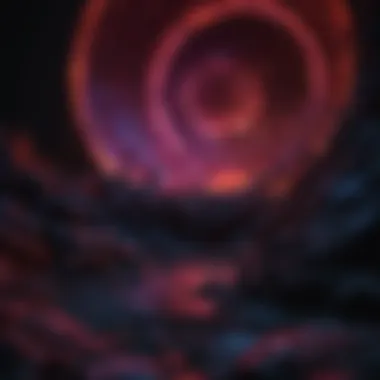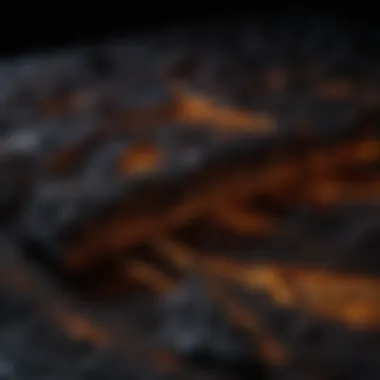Unveiling the Enigmatic World of Ultraviolet Black Lights


Rock and Fossil Identification
Black lights have a fascinating role in exploring and identifying various rocks and fossils 🔍. By emitting ultraviolet (UV) light, these enigmatic light sources can unveil unique characteristics that are typically invisible to the naked eye. Types of rocks and fossils exhibit distinct fluorescence patterns under black light, aiding enthusiasts and professionals in categorizing and differentiating specimens. The identification process involves observing specific fluorescence colors and patterns, which are indicative of certain minerals or organic materials. Utilizing tools such as UV light lamps and filters enhances the detection of fluorescence, allowing for a more detailed analysis of rock and fossil compositions. Understanding these key aspects of rock and fossil identification under black lights is crucial for enthusiasts and researchers alike.
Collecting Tips and Techniques
For rock and fossil collectors, leveraging black lights can significantly enhance their collecting practices 🌌. When scouting for specimens, it is essential to consider optimal conditions for fluorescence observation, such as conducting searches in low-light environments to maximize the effect of UV radiation. Locating prime collecting sites can be a strategic endeavor, focusing on areas rich in minerals or fossils known for their fluorescent properties under black light. Additionally, extracting specimens safely requires precision and care to avoid damage and ensure the preservation of valuable finds. By implementing best practices and techniques tailored to black light usage, collectors can elevate their exploration and discovery experiences.
Preservation and Display
Preserving rocks and fossils discovered through black light exploration is a meticulous process that necessitates specific techniques 🖼️. To maintain the fluorescence properties of specimens, preservation methods include storing items in UV-protective containers or display cases to shield them from excessive light exposure. Proper storage practices, such as controlling humidity levels and temperature conditions, play a vital role in safeguarding the integrity of collected rocks and fossils. Furthermore, enthusiasts can unleash their creativity by devising innovative display ideas that not only showcase the fluorescence of specimens but also contribute to engaging and educational exhibits for viewers.
Geological Insights
Delving into the geological insights offered by black lights expands our understanding of the Earth's history and processes 🌍. By examining geological formations under UV illumination, researchers can unravel millennia-old patterns and structures, shedding light on the intricate evolution of landscapes. Rocks and fossils that fluoresce under black light provide valuable clues about past environments and the biological organisms that inhabited them. The historical significance of notable discoveries in the field of geology, facilitated by black light technology, underscores the profound impact of these light sources on advancing our knowledge of Earth's geological past.
Preamble to Black Lights
In the vast expanse of illumination, black lights stand out as enigmatic sources of radiance, intriguing both enthusiasts and scientists alike. This section delves into the essence of black lights, unraveling their unique properties, applications, and transcendental impact. Delving deeper beyond the surface, we uncover the mystical allure of black lights that permeates various industries and disciplines.
Understanding the Basics
Definition of Black Lights
The cornerstone of understanding black lights lies in their essence of emitting ultraviolet radiation, often referred to as UV light. This distinctive feature sets black lights apart in the realm of illumination technology, offering a spectrum of light beyond human vision. Its prowess in illuminating fluorescent materials discreetly underscore its significance in various applications, from forensics to entertainment, making it a versatile tool worth exploring rigorously.
Characteristics and Properties
Exploring the tapestry of characteristics and properties of black lights reveals a myriad of facets that contribute to their allure. From their ability to trigger fluorescence in materials to their utilization in detecting hidden substances, black lights showcase a blend of versatility and precision. Despite the risks associated with UV exposure, harnessing the power of black lights with caution opens doors to a realm of invisible manifestations, enhancing industries and scientific endeavors alike.
Historical Perspective
Origins of Black Lights


The genesis of black lights traces back to early explorations in ultraviolet radiation, where pioneers sought to unveil the unseen through a cloak of darkness. Unraveling the origins of black lights unveils a narrative of curiosity, innovation, and technological evolution that shaped their trajectory. Embedded in the historical fabric of discovery, black lights emerged as beacons of distinction, guiding scientific inquiry and artistic expression towards uncharted territories.
Evolution of Technology
The evolution of black light technology heralds a transformative journey from incandescent bulbs to advanced UV LEDs, marking a paradigm shift in efficiency and performance. Through iterative advancements, black lights have transcended conventional limitations, finding applications in emerging industries and cutting-edge research. Navigating the winds of change, the technological progression of black lights highlights a synergy of ingenuity and utility, propelling the discourse towards futuristic horizons.
Science Behind Black Lights
Black lights, a mysterious aspect of our luminous world, are not merely illuminating but hold incomprehensible allure within the confines of their ultraviolet emissions. Delving into the intricate framework of the science behind black lights unveils a realm of electromagnetic waves unseen by the naked eye, breaching the boundaries of conventional light sources. This section unveils the significance of comprehending the scientific essence of black lights, offering invaluable insights into the wavelength dynamics and fluorescence phenomena that underpin their enigmatic glow.
Ultraviolet Light Spectrum
Different Types of UV Light
In the vast expanse of the ultraviolet light spectrum, diverse classifications of UV rays punctuate the continuum, ranging from UVA to UVB and UVC with varying degrees of energy and penetration levels. Each classification delineates a distinct impact on materials and living organisms, showcasing a kaleidoscope of effects that shape their optimum usage across industries. Understanding the nuanced characteristics of each UV type provides a comprehensive perspective on harnessing their potential in diverse applications, from sterilization methods to photochemical reactions, laying the foundation for innovation and discovery.
Wavelengths and Energy Levels
Traversing the crux of ultraviolet light properties, wavelengths and energy levels dictate the behavior and interaction of light with matter, embodying crucial determinants in fluorescence scenarios. The unique oscillation frequencies of UV light particles govern their penetrative capabilities and photochemical reactivity, elucidating the imperative role they play in scientific endeavors. Aligning wavelength specifics with intended outcomes enables precision in utilizing UV light for an array of tasks, from medical diagnostics to industrial curing processes, empowering industries with unparalleled efficiency and accuracy.
Fluorescence Phenomenon
How Fluorescent Materials React
Emanating a surreal luminescence under black light scrutiny, fluorescent materials exhibit a remarkable attribute of absorbing UV energy and re-emitting it as visible light, enthusing a vibrant display of colors that captivate the observer's gaze. Unraveling the intricate dance between fluorescent elements and ultraviolet photons delineates the captivating transformation these materials undergo when exposed to specific wavelengths, transcending ordinary aesthetics to impart a mystique aura that transcends conventional visual realms.
Principles of Fluorescence
Rooted in the quantum mechanics of electron excitation and relaxation processes, the principles governing fluorescence manifest a mesmerizing interplay of energy conversion and emission, orchestrating a symphony of light reactions that underscore the essence of black light applications. Understanding the intricate mechanisms that propel fluorescence phenomena unlocks a trove of opportunities for innovative solutions, amplifying the versatility of these luminous beacons across scientific, artistic, and industrial domains, heralding a new era of exploration and discovery.
Applications of Black Lights
Diving deep into the applications of black lights unveils a world of possibilities that extend beyond mere illumination. Black lights, with their unique properties, play a critical role in various industries and fields. The ability of black lights to reveal hidden elements and fluoresce materials makes them indispensable in different applications. Understanding the nuances of how black lights are utilized enhances our comprehension of their significance.


Forensic Science
Crime Scene Investigations
Crime scene investigations harness the power of black lights to uncover elusive evidence that might be invisible to the naked eye. By illuminating biological fluids, fibers, or other trace materials that fluoresce under UV light, black lights aid forensic experts in piecing together crucial information. The discreet nature of black light illumination allows for a meticulous examination of crime scenes in search of vital clues. Despite its efficacy, the overreliance on black lights may lead to potential oversight of non-fluorescing evidence, necessitating a balanced investigative approach.
Detection of Biological Fluids
The detection of biological fluids under black lights revolutionizes forensic analysis, enabling swift and accurate identification. By exploiting the fluorescence properties of bodily fluids like blood, saliva, or urine, investigators can isolate specific stains for further examination. This targeted approach streamlines the evidence collection process, saving valuable time in criminal investigations. However, it is crucial to acknowledge the limitations of this method, as environmental factors and the quality of materials can affect the detection accuracy.
Art and Entertainment
Black Light Theatrical Performances
Black light theatrical performances mesmerize audiences with their ethereal glow and captivating effects. The strategic use of black lights in stage productions enhances visual appeal and creates stunning illusions. The surreal ambiance created by UV reactive materials under black light adds a layer of intrigue to theatrical storytelling. Despite its artistic brilliance, the reliance on black lights demands meticulous planning to control light dispersion and maintain a seamless visual experience for spectators.
UV-Responsive Art
UV-responsive art thrives under the enchanting glow of black lights, revealing intricate details and vibrant hues that aren't perceptible in regular light. Artists harness the fluorescence phenomenon to infuse their creations with an otherworldly charm that captivates viewers. The interplay between UV light and specialized pigments or dyes unlocks a realm of creative possibilities, inviting exploration and experimentation. Nonetheless, artists must consider the longevity and stability of UV-reactive elements to ensure the preservation of their works over time.
Industrial and Commercial Uses
Quality Control in Manufacturing
Quality control mechanisms leverage the precision of black lights to detect imperfections or irregularities in manufactured products. By subjecting items to UV inspection, manufacturers can identify flaws like cracks, contaminants, or inconsistencies that might compromise product quality. The non-destructive nature of black light inspections minimizes waste and facilitates targeted interventions to rectify issues promptly. However, vigilance is necessary to avoid false positives and interpret fluorescence patterns accurately.
Leak Detection
Leak detection procedures benefit significantly from the sensitivity of black lights in spotting fluid or gas leaks that evade visual detection. The ability of black lights to reveal the presence of fluorescent dyes added to liquids for detection purposes enhances leak tracing efficiency. By swiftly pinpointing leak sources, maintenance teams can address potential hazards promptly, safeguarding equipment and preventing costly downtime. Mitigating sources of contamination is crucial to ensure accurate leak detection and prevent misinterpretation of fluorescing substances.
Practical Tips and Safety Precautions
In the realm of black lights, understanding practical tips and safety precautions is paramount for a seamless and secure experience. These guidelines act as beacons of knowledge, illuminating the path towards efficient utilization and risk mitigation. By grasping the essence of practical tips and safety precautions, enthusiasts and professionals alike can navigate the intricacies of black light usage with finesse.


Optimizing Black Light Effectiveness
Proper Usage Guidelines
Proper usage guidelines serve as the cornerstone of harnessing black light effectiveness within the desired parameters. These instructions form a roadmap for users, delineating the dos and don'ts of maximizing the illuminative potential of black lights. The pivotal characteristic of proper usage guidelines lies in their ability to streamline operations and enhance outcomes in a controlled manner, making them a favored choice for individuals seeking precision and quality in their black light endeavors.
Maintenance and Care Tips
Care tips and maintenance procedures play a vital role in ensuring the longevity and functionality of black lights. By adhering to recommended maintenance practices, users can prolong the life expectancy of their equipment and preserve optimal performance levels. The distinctive feature of maintenance and care tips lies in their proactive approach towards safeguarding investments and preventing untimely malfunctions. While they demand vigilance and dedication, their benefits in sustaining efficiency and reliability within this domain are unparalleled.
Ensuring Safety
Eye Protection Measures
The implementation of eye protection measures is non-negotiable when engaging with black lights to shield against harmful wavelengths and potential ocular damage. Emphasizing eye protection underscores a commitment to personal well-being and safety, underscoring its indispensability within this narrative. The remarkable feature of eye protection measures is their ability to provide a visual barrier against ultraviolet radiation, safeguarding vision and health in the process.
Avoiding UV Exposure
Mitigating UV exposure risks is imperative in the context of black light usage to prevent adverse health effects and overexposure. The significance of avoiding UV exposure lies in upholding a balance between engagement and safety, optimizing the benefits of black lights without compromising on well-being. The distinguishing trait of strategies aimed at avoiding UV exposure is their proactive stance in preserving health integrity while harnessing the power of black lights without reservation.
Future Innovations and Advancements
In the expansive realm of black lights, Future Innovations and Advancements stand as a beacon of progress and evolution. This pivotal section encapsulates the driving force behind the continual improvement and refinement of black light technology. It delves deep into the significance of embracing cutting-edge advancements to enhance the efficacy and versatility of black lights in diverse applications. By shedding light on the ongoing transformation within the industry, this segment aims to enlighten readers about the exciting prospects on the horizon.
Technological Developments
Enhanced UV LEDs
Enhanced UV LEDs represent a quantum leap in the evolution of black light technology. Their unrivaled luminosity and energy efficiency set a new benchmark for performance in various applications. The key characteristic of Enhanced UV LEDs lies in their ability to emit a concentrated beam of high-intensity ultraviolet light, crucial for maximizing fluorescence effects and detection accuracy. This efficiency makes them a preferred choice for applications requiring precision and reliability, such as forensic investigations and industrial inspections. In addition, Enhanced UV LEDs boast a unique feature of minimal heat generation, ensuring prolonged operational lifespan and reduced maintenance costs in comparison to traditional lighting sources.
Applications in Emerging Industries
The integration of black lights in Emerging Industries signals a paradigm shift in the utilization of ultraviolet technology. This segment explores the intersection of innovation and practicality, showcasing how black lights are revolutionizing sectors such as healthcare, agriculture, and nanotechnology. The key characteristic of Applications in Emerging Industries lies in their adaptability and versatility to meet the dynamic demands of modern businesses. Their ability to uncover hidden insights, sterilize environments, and enhance material properties underscores their paramount importance in driving efficiency and productivity. However, one must acknowledge that their widespread adoption may trigger challenges regarding standardization and safety protocols, necessitating comprehensive industry guidelines and regulations.
Environmental Considerations
The discourse on black lights extends beyond technological prowess to encompass Environmental Considerations, highlighting the responsibility towards sustainable practices and ecological impact. This section underscores the critical need to balance technological progress with environmental preservation, urging stakeholders to adopt eco-conscious approaches in black light applications. The focus on Sustainable Practices emphasizes the integration of recyclable materials, energy-efficient components, and eco-friendly processes in black light manufacturing and usage. Such practices not only reduce carbon footprint and resource depletion but also foster a culture of environmental stewardship within the industry.
Impact on Ecosystems
Exploring the Impact on Ecosystems reveals the intertwined relationship between black light technology and the natural world. This aspect elucidates how the widespread use of black lights can potentially influence ecosystems and biological diversity. The key characteristic of Impact on Ecosystems lies in its capacity to mitigate light pollution, preserve nocturnal habitats, and protect vulnerable species from anthropogenic disruptions. However, it is imperative to acknowledge the potential drawbacks, such as habitat alteration and behavioral changes in certain organisms, warranting thorough environmental impact assessments and mitigation strategies to ensure sustainable coexistence.







